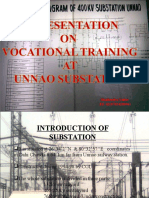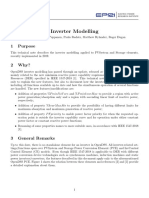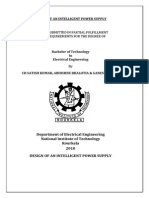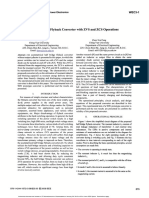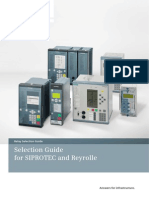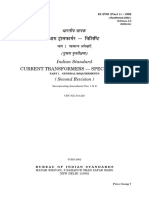100%(1)100% found this document useful (1 vote)
159 viewsApplication of Power Circuit Breakers For Switching Capacitive and Light Inductive Currents
Application of Power Circuit Breakers For Switching Capacitive and Light Inductive Currents
Uploaded by
shawnr7376This document is a presentation on capacitor and reactor switching given at an IEEE Circuit Breaker Tutorial. It discusses the nature of capacitive and small inductive currents that circuit breakers are frequently called upon to switch. It provides an overview of issues related to switching shunt capacitor banks and reactors, including interrupting continuous current, restriking, energization, and mitigation of transients. Controlled closing techniques are presented for mitigating inrush currents and switching surges.
Copyright:
Attribution Non-Commercial (BY-NC)
Available Formats
Download as PDF, TXT or read online from Scribd
Application of Power Circuit Breakers For Switching Capacitive and Light Inductive Currents
Application of Power Circuit Breakers For Switching Capacitive and Light Inductive Currents
Uploaded by
shawnr7376100%(1)100% found this document useful (1 vote)
159 views0 pagesThis document is a presentation on capacitor and reactor switching given at an IEEE Circuit Breaker Tutorial. It discusses the nature of capacitive and small inductive currents that circuit breakers are frequently called upon to switch. It provides an overview of issues related to switching shunt capacitor banks and reactors, including interrupting continuous current, restriking, energization, and mitigation of transients. Controlled closing techniques are presented for mitigating inrush currents and switching surges.
Original Description:
switching
Original Title
Part6_SwitchingCapacitiveandLightInductiveCurrentsfinal2-JBrunke.pdf
Copyright
© Attribution Non-Commercial (BY-NC)
Available Formats
PDF, TXT or read online from Scribd
Share this document
Did you find this document useful?
Is this content inappropriate?
This document is a presentation on capacitor and reactor switching given at an IEEE Circuit Breaker Tutorial. It discusses the nature of capacitive and small inductive currents that circuit breakers are frequently called upon to switch. It provides an overview of issues related to switching shunt capacitor banks and reactors, including interrupting continuous current, restriking, energization, and mitigation of transients. Controlled closing techniques are presented for mitigating inrush currents and switching surges.
Copyright:
Attribution Non-Commercial (BY-NC)
Available Formats
Download as PDF, TXT or read online from Scribd
Download as pdf or txt
100%(1)100% found this document useful (1 vote)
159 views0 pagesApplication of Power Circuit Breakers For Switching Capacitive and Light Inductive Currents
Application of Power Circuit Breakers For Switching Capacitive and Light Inductive Currents
Uploaded by
shawnr7376This document is a presentation on capacitor and reactor switching given at an IEEE Circuit Breaker Tutorial. It discusses the nature of capacitive and small inductive currents that circuit breakers are frequently called upon to switch. It provides an overview of issues related to switching shunt capacitor banks and reactors, including interrupting continuous current, restriking, energization, and mitigation of transients. Controlled closing techniques are presented for mitigating inrush currents and switching surges.
Copyright:
Attribution Non-Commercial (BY-NC)
Available Formats
Download as PDF, TXT or read online from Scribd
Download as pdf or txt
You are on page 1of 0
Page 1
Capacitor and Reactor Switching, J . H. Brunke, J uly 2008
Presented at IEEE Circuit Breaker Tutorial
Application of Power Circuit Breakers for
Switching Capacitive and Light Inductive
Currents
IEEE Circuit Breaker Tutorial
Dr. J ohn H. Brunke, P.E.
Fellow
Page 2
Capacitor and Reactor Switching, J . H. Brunke, J uly 2008
Presented at IEEE Circuit Breaker Tutorial
Nature of Capacitive and Small Inductive Currents
Small in magnitude
Some technologies use current to assist in interruption
Current and voltage 90 degrees out of phase
Circuit breakers frequently called upon to deal with switching these
currents
Switching can result in extreme magnitudes of currents and extreme
rates of change of voltage
This presentation is based on C37.012 and C37.015, the application
guides for switching these currents. It is impossible to cover all the
material in these in detail, and there are other important issues with
switching these currents that are not covered in the application guides.
This presentation is intended to provide an overview of all the issues
associated with switching these currents.
Page 3
Capacitor and Reactor Switching, J . H. Brunke, J uly 2008
Presented at IEEE Circuit Breaker Tutorial
Shunt Capacitor Bank Switching
Continuous Current
Margins for capacitor tolerance
Margins for harmonic current
Margin of 35% typical
Interrupting shunt capacitor bank current
Page 4
Capacitor and Reactor Switching, J . H. Brunke, J uly 2008
Presented at IEEE Circuit Breaker Tutorial
What is a Restrike?
Page 5
Capacitor and Reactor Switching, J . H. Brunke, J uly 2008
Presented at IEEE Circuit Breaker Tutorial
Restrike, Back to Back with CLRs
Page 6
Capacitor and Reactor Switching, J . H. Brunke, J uly 2008
Presented at IEEE Circuit Breaker Tutorial
Energizing Shunt Capacitor Banks
Single or isolated bank
Back to back
Page 7
Capacitor and Reactor Switching, J . H. Brunke, J uly 2008
Presented at IEEE Circuit Breaker Tutorial
500 kV Single Bank Energization
Page 8
Capacitor and Reactor Switching, J . H. Brunke, J uly 2008
Presented at IEEE Circuit Breaker Tutorial
500 kV Back to Back Energization
Page 9
Capacitor and Reactor Switching, J . H. Brunke, J uly 2008
Presented at IEEE Circuit Breaker Tutorial
Consequences of Capacitor Inrush Transients
Dip to zero voltage
Interference with devices that use zero crossing detectors
Back to back results in extremely high currents
Damage to primary and secondary equipment
Safety
Restrike (trapped charge)
2 X the voltage, effects 2 X
Page 10
Capacitor and Reactor Switching, J . H. Brunke, J uly 2008
Presented at IEEE Circuit Breaker Tutorial
Mitigation of Closing Transients
Closing Resistor or Reactor
Fixed Current Limiting Reactor
Controlled closing
Page 11
Capacitor and Reactor Switching, J . H. Brunke, J uly 2008
Presented at IEEE Circuit Breaker Tutorial
500 kV Back to Back Energization with CLR
Page 12
Capacitor and Reactor Switching, J . H. Brunke, J uly 2008
Presented at IEEE Circuit Breaker Tutorial
Controlled Closing, Single Bank
Page 13
Capacitor and Reactor Switching, J . H. Brunke, J uly 2008
Presented at IEEE Circuit Breaker Tutorial
Controlled Closing, Back to Back
Page 14
Capacitor and Reactor Switching, J . H. Brunke, J uly 2008
Presented at IEEE Circuit Breaker Tutorial
Controlled Closing, Capacitor Banks,
targeting
Page 15
Capacitor and Reactor Switching, J . H. Brunke, J uly 2008
Presented at IEEE Circuit Breaker Tutorial
Switching Capacitor Through a Transformer
Page 16
Capacitor and Reactor Switching, J . H. Brunke, J uly 2008
Presented at IEEE Circuit Breaker Tutorial
Faults Near Capacitor Banks
Outrush, TRV effects, high source impedance
voltage rises (or long lining), etc.
Page 17
Capacitor and Reactor Switching, J . H. Brunke, J uly 2008
Presented at IEEE Circuit Breaker Tutorial
Line Fault, 500 kV system, with 430 Mvar of Connected
Capacitors
Page 18
Capacitor and Reactor Switching, J . H. Brunke, J uly 2008
Presented at IEEE Circuit Breaker Tutorial
Circuit Breaker Standards
Restrike probability: C0, no rating, C1, ~ 1 restrike in 50 operations, C2, ~1 restrike in 300 operations
Page 19
Capacitor and Reactor Switching, J . H. Brunke, J uly 2008
Presented at IEEE Circuit Breaker Tutorial
Circuit Breaker Standards
Page 20
Capacitor and Reactor Switching, J . H. Brunke, J uly 2008
Presented at IEEE Circuit Breaker Tutorial
Switching Overhead Transmission Lines - Interruption
Page 21
Capacitor and Reactor Switching, J . H. Brunke, J uly 2008
Presented at IEEE Circuit Breaker Tutorial
Switching Overhead Transmission Lines
Page 22
Capacitor and Reactor Switching, J . H. Brunke, J uly 2008
Presented at IEEE Circuit Breaker Tutorial
Charging Current and Recovery Voltage
Page 23
Capacitor and Reactor Switching, J . H. Brunke, J uly 2008
Presented at IEEE Circuit Breaker Tutorial
Recovery Voltage on Unfaulted Phases
Neutral shift, coupling of transients
Page 24
Capacitor and Reactor Switching, J . H. Brunke, J uly 2008
Presented at IEEE Circuit Breaker Tutorial
De-energization of a Line with Connected
Transformer
Page 25
Capacitor and Reactor Switching, J . H. Brunke, J uly 2008
Presented at IEEE Circuit Breaker Tutorial
Energization of Transmission Lines, Switching Surges
Page 26
Capacitor and Reactor Switching, J . H. Brunke, J uly 2008
Presented at IEEE Circuit Breaker Tutorial
Switching Surge Overvoltages
Page 27
Capacitor and Reactor Switching, J . H. Brunke, J uly 2008
Presented at IEEE Circuit Breaker Tutorial
Switching Surge Mitigation
Only needed above 245 kV (rarely at 245 kV)
Closing resistors
Line connected surge arresters
Controlled closing
Trapped charge reduction (line connected PTs caution)
Single pole reclosing (limited due to secondary arc)
Controlled closing
Staggered pole closing
Page 28
Capacitor and Reactor Switching, J . H. Brunke, J uly 2008
Presented at IEEE Circuit Breaker Tutorial
Traveling Waves Present on Most Line Phenomena
Closing into a fault, 500 kV field test data.
Page 29
Capacitor and Reactor Switching, J . H. Brunke, J uly 2008
Presented at IEEE Circuit Breaker Tutorial
Shunt Reactor Switching
1
st
Parallel 1 to 10 MHz
2
nd
parallel 50 to 1000 kHZ
Load oscillation 1 to 5 kHz
Page 30
Capacitor and Reactor Switching, J . H. Brunke, J uly 2008
Presented at IEEE Circuit Breaker Tutorial
225 Mvar Shunt Reactor Interruption
500 kV bus and reactor voltages, field test data
Page 31
Capacitor and Reactor Switching, J . H. Brunke, J uly 2008
Presented at IEEE Circuit Breaker Tutorial
Time Expansion of Previous Slide
Page 32
Capacitor and Reactor Switching, J . H. Brunke, J uly 2008
Presented at IEEE Circuit Breaker Tutorial
Re-ignition and Current Chopping
Page 33
Capacitor and Reactor Switching, J . H. Brunke, J uly 2008
Presented at IEEE Circuit Breaker Tutorial
Time Expansion of Previous Slide
Page 34
Capacitor and Reactor Switching, J . H. Brunke, J uly 2008
Presented at IEEE Circuit Breaker Tutorial
Reactor Current Interruption Failure
Interruption still a difficult duty for circuit
breakers
Differences in the parameters make a standard
test nearly impossible
Page 35
Capacitor and Reactor Switching, J . H. Brunke, J uly 2008
Presented at IEEE Circuit Breaker Tutorial
Shunt Reactor Current Interruption w/o
Controlled Opening
Page 36
Capacitor and Reactor Switching, J . H. Brunke, J uly 2008
Presented at IEEE Circuit Breaker Tutorial
Shunt Reactor Current Interruption with
Controlled Opening
Page 37
Capacitor and Reactor Switching, J . H. Brunke, J uly 2008
Presented at IEEE Circuit Breaker Tutorial
Energizing Shunt Reactors
Inrush currents smaller than for power transformers (to be discussed
next), and not generally considered a problem
Can cause sympathetic inrush in nearby power transformers
Problems have only been observed in certain configurations
Page 38
Capacitor and Reactor Switching, J . H. Brunke, J uly 2008
Presented at IEEE Circuit Breaker Tutorial
Switching Transformer Magnetizing Currents
Page 39
Capacitor and Reactor Switching, J . H. Brunke, J uly 2008
Presented at IEEE Circuit Breaker Tutorial
Transformer Core Characteristic
Page 40
Capacitor and Reactor Switching, J . H. Brunke, J uly 2008
Presented at IEEE Circuit Breaker Tutorial
Magnetizing Current Interruption
Magnetizing current interruption also showing core flux
Residual core flux remains (typical pattern)
Page 41
Capacitor and Reactor Switching, J . H. Brunke, J uly 2008
Presented at IEEE Circuit Breaker Tutorial
Energizing a Transformer
Page 42
Capacitor and Reactor Switching, J . H. Brunke, J uly 2008
Presented at IEEE Circuit Breaker Tutorial
Inrush Current
Page 43
Capacitor and Reactor Switching, J . H. Brunke, J uly 2008
Presented at IEEE Circuit Breaker Tutorial
Controlled Closing Applied to Transformers
Page 44
Capacitor and Reactor Switching, J . H. Brunke, J uly 2008
Presented at IEEE Circuit Breaker Tutorial
Three Phase Transformers
Page 45
Capacitor and Reactor Switching, J . H. Brunke, J uly 2008
Presented at IEEE Circuit Breaker Tutorial
Prospective and Dynamic Flux
58.0 54.0 50.0 46.0 42.0
T ime ms
F lux, residual 0%, -70%, 70%
0.80
0.0
-0.80
F lux kVs
A C B
Page 46
Capacitor and Reactor Switching, J . H. Brunke, J uly 2008
Presented at IEEE Circuit Breaker Tutorial
Core Flux - No residual
Page 47
Capacitor and Reactor Switching, J . H. Brunke, J uly 2008
Presented at IEEE Circuit Breaker Tutorial
Core flux with residual flux
Time 6 ms/div
Core flux, EMTP Study
800
0.0
-800
Vs
Page 48
Capacitor and Reactor Switching, J . H. Brunke, J uly 2008
Presented at IEEE Circuit Breaker Tutorial
Verification - Laboratory Tests
Delayed Closing Strategy
T i m e 6 m s / d i v
. 8 0 0 0
0 . 0
- . 8 0 0 0
V s
Page 49
Capacitor and Reactor Switching, J . H. Brunke, J uly 2008
Presented at IEEE Circuit Breaker Tutorial
Test on Laboratory Transformer
Page 50
Capacitor and Reactor Switching, J . H. Brunke, J uly 2008
Presented at IEEE Circuit Breaker Tutorial
Controlled Closing on 500 kV Transformer
Page 51
Capacitor and Reactor Switching, J . H. Brunke, J uly 2008
Presented at IEEE Circuit Breaker Tutorial
Summary
Capacitive and light reactive currents are frequently seen and may be
the most difficult duties for a circuit breaker
Switching surge/transient problems are typically associated with
switching shunt capacitor banks, shunt reactors, transformers, cables,
and lines (capacitive and light reactive currents).
Due to the complexity, correct application for these duties can be
among the most difficult application issues
Today solutions are available which were not in the past (modern circuit
breaker technologies, controlled switching, MOSAs, etc.)
Questions?
You might also like
- ZMG310AR/CR, ZxG400AR/CR E550 Series 2Document390 pagesZMG310AR/CR, ZxG400AR/CR E550 Series 2Iv Ruiz M100% (1)
- The Technology of Instrument Transformers: Current and Voltage Measurement and Insulation SystemsFrom EverandThe Technology of Instrument Transformers: Current and Voltage Measurement and Insulation SystemsNo ratings yet
- MV Switchgear Historical EvolutionDocument26 pagesMV Switchgear Historical EvolutionJuan TobiasNo ratings yet
- User Manual WR BSM30kDocument38 pagesUser Manual WR BSM30kChingiz KhudaverdiyevNo ratings yet
- The EPRI Zed-MeterDocument82 pagesThe EPRI Zed-Metershawnr7376No ratings yet
- Understanding The Zed Meter PDFDocument150 pagesUnderstanding The Zed Meter PDFshawnr7376No ratings yet
- Live Tank Circuit Breakers (MODELO - LTB123D1B) PDFDocument152 pagesLive Tank Circuit Breakers (MODELO - LTB123D1B) PDFclaudia tarattiniNo ratings yet
- 7UT6 Transformer Differential Protection: Vector Group, Io-Elimination, Io-CorrectionDocument11 pages7UT6 Transformer Differential Protection: Vector Group, Io-Elimination, Io-Correctionpraful varsadaNo ratings yet
- Variable Shunt Reactors Cigre2014 A2 211 2014Document8 pagesVariable Shunt Reactors Cigre2014 A2 211 2014StrahinjaNo ratings yet
- L9-Impulse Voltages and TestingDocument72 pagesL9-Impulse Voltages and TestingDante Filho100% (1)
- Day 2 TransformersDocument106 pagesDay 2 TransformersEzequiel Juarez BenítezNo ratings yet
- Screen BondingDocument38 pagesScreen BondingMoataz Eweda100% (1)
- Paper KimbarkDocument6 pagesPaper KimbarkRamiro VasquezNo ratings yet
- Statnett Digital SubstationDocument29 pagesStatnett Digital SubstationAbib LeyeNo ratings yet
- Optical Current & Voltage Sensors: Eric Langford, Langford & Associates John Swindlehurst, P.Eng, Nxtphase T&D CorpDocument38 pagesOptical Current & Voltage Sensors: Eric Langford, Langford & Associates John Swindlehurst, P.Eng, Nxtphase T&D CorpKrishna Venkataraman100% (1)
- Cable Sheath Surge Voltage LimiterDocument2 pagesCable Sheath Surge Voltage LimiterDes LawlessNo ratings yet
- Z.Gajic - Using IECDocument22 pagesZ.Gajic - Using IECannymagoNo ratings yet
- SVLDocument32 pagesSVLSer 345No ratings yet
- Ferro ResonanceDocument67 pagesFerro ResonanceAnand SinghNo ratings yet
- Identification of Problems When Using Long High VoDocument8 pagesIdentification of Problems When Using Long High VoMichael KnopNo ratings yet
- Veryy Little 400kv Substation Training ReportDocument31 pagesVeryy Little 400kv Substation Training Reportkra_amNo ratings yet
- Nexans - Olivier AngoulevantDocument30 pagesNexans - Olivier AngoulevanttomkhaiNo ratings yet
- Transient Recovery Voltage AnalysisDocument18 pagesTransient Recovery Voltage AnalysisJosNo ratings yet
- VIZIMAX - CIGRE Toronto - Using A Controlled Switching Device For A Power Transformer PDFDocument8 pagesVIZIMAX - CIGRE Toronto - Using A Controlled Switching Device For A Power Transformer PDFgeorge_cpp2No ratings yet
- 04 - D01 - Communication Modules - V1.0 - en-USDocument14 pages04 - D01 - Communication Modules - V1.0 - en-UScacobecoNo ratings yet
- Cable With Standing CurvesDocument63 pagesCable With Standing CurvesRatheesh R NairNo ratings yet
- Single Core Cables in ParallelDocument1 pageSingle Core Cables in ParallelAamirMalik100% (1)
- Emtp PDFDocument34 pagesEmtp PDFagkacdm1163100% (1)
- IEEEPESApr14 - Grounding Configurations and Detection!Document66 pagesIEEEPESApr14 - Grounding Configurations and Detection!MrNo ratings yet
- Inverter Modelling: 1 PurposeDocument23 pagesInverter Modelling: 1 PurposeLeonardo LeonNo ratings yet
- Koncar Ket PresentationDocument130 pagesKoncar Ket Presentationgeni143No ratings yet
- VLF FaqDocument4 pagesVLF Faqminhduc ngoNo ratings yet
- 2008-GM Tutorial 1 NelsonDocument81 pages2008-GM Tutorial 1 NelsonCarlos AvalosNo ratings yet
- OverexcitationOverTime - SiemensDocument3 pagesOverexcitationOverTime - SiemensAndré LuizNo ratings yet
- Application Development Trend in HV GIS Industry - 2013.10.24Document41 pagesApplication Development Trend in HV GIS Industry - 2013.10.24Aryabhatt ThakurNo ratings yet
- Catalog Composite+Insulator-CNME PDFDocument31 pagesCatalog Composite+Insulator-CNME PDFAneelNo ratings yet
- CIGRE+IEEE+Tutorial+2012+part+4+HSGS+DS+ES Kosakada For CIGREwebpage PDFDocument59 pagesCIGRE+IEEE+Tutorial+2012+part+4+HSGS+DS+ES Kosakada For CIGREwebpage PDFmorrissubhashNo ratings yet
- Shunt Reactors ABBDocument17 pagesShunt Reactors ABBTaher El NoamanNo ratings yet
- 1KHF602000-E Interlocking GuidelineDocument40 pages1KHF602000-E Interlocking GuidelineGabriel Romero cortés100% (1)
- Gult-TS1-GTS1 - Sheath Voltage Cal - 2016!07!10Document31 pagesGult-TS1-GTS1 - Sheath Voltage Cal - 2016!07!10Apichartj JusuayNo ratings yet
- ABB Non Directional Earth Fault Setting GuideDocument8 pagesABB Non Directional Earth Fault Setting GuideKarthikeyan GuruNo ratings yet
- TRV For High Voltage CBDocument19 pagesTRV For High Voltage CBalpcruzNo ratings yet
- HVDC FinalDocument26 pagesHVDC FinalGoutham MadarapuNo ratings yet
- Accuracy of Furanic Compound Analysis in Determining The Ageing of Power TransformersDocument4 pagesAccuracy of Furanic Compound Analysis in Determining The Ageing of Power TransformersLucas BrasileiroNo ratings yet
- Kries-Energietechnik Catalogue 8 2017 EDocument88 pagesKries-Energietechnik Catalogue 8 2017 EANTONIO SOLISNo ratings yet
- Testing The Performance of IEC 61850 Substation Automation DesignsDocument100 pagesTesting The Performance of IEC 61850 Substation Automation DesignsManuel Henríquez Santana100% (2)
- Current Transformer Rev1Document26 pagesCurrent Transformer Rev1adi_sofa100% (1)
- Calculation of Induced Sheath Voltage FoDocument6 pagesCalculation of Induced Sheath Voltage FoKrasimir Ivanov100% (1)
- b1-108 - Underground of LondonDocument8 pagesb1-108 - Underground of LondonLuisa De CairesNo ratings yet
- Neutral Grounding Professor Ahdab ElmorshedyDocument35 pagesNeutral Grounding Professor Ahdab ElmorshedyRama PrasadNo ratings yet
- Review of Sys GroundingDocument38 pagesReview of Sys GroundingChilamkurti Siva Sankara RaoNo ratings yet
- Hotspot Location and Mitigation For Underground Power CablesDocument5 pagesHotspot Location and Mitigation For Underground Power CablesCarlos LiceaNo ratings yet
- Ehv Gis SubstationDocument6 pagesEhv Gis SubstationelectricalrakeshNo ratings yet
- F10 Taps in Auto Transformers SlidesDocument42 pagesF10 Taps in Auto Transformers Slidesverma210100% (1)
- B1 105 2012 PDFDocument11 pagesB1 105 2012 PDFZeckrey JikurunNo ratings yet
- Current Interruption Transients CalculationFrom EverandCurrent Interruption Transients CalculationRating: 4 out of 5 stars4/5 (1)
- VSC-FACTS-HVDC: Analysis, Modelling and Simulation in Power GridsFrom EverandVSC-FACTS-HVDC: Analysis, Modelling and Simulation in Power GridsNo ratings yet
- J-ISI-2023-Soft Switching Non-Isolated Interleaved PWM Cuk Converter With One Auxiliary Switch Used in PV ApplicationDocument11 pagesJ-ISI-2023-Soft Switching Non-Isolated Interleaved PWM Cuk Converter With One Auxiliary Switch Used in PV ApplicationshahramjNo ratings yet
- Power Electronics: Faculty-In-Charge: Dr. Sitangshu BhattacharyaDocument27 pagesPower Electronics: Faculty-In-Charge: Dr. Sitangshu BhattacharyaShivanshu TrivediNo ratings yet
- Intelligent Power Supply Design and Its DescriptionDocument45 pagesIntelligent Power Supply Design and Its Descriptionmilind kailaNo ratings yet
- Electronic Devices & Circuits (EDC) PE-124: Prepared By: Engr. Shafaq EjazDocument19 pagesElectronic Devices & Circuits (EDC) PE-124: Prepared By: Engr. Shafaq EjazShafaq EjazNo ratings yet
- Tempeletefor FYDP2Document27 pagesTempeletefor FYDP2hgnishsuya066No ratings yet
- Paper 2002Document12 pagesPaper 2002Miguel VenzNo ratings yet
- A Half Bridge Flyback Converter With ZVS and ZCS Operations: ExeoDocument7 pagesA Half Bridge Flyback Converter With ZVS and ZCS Operations: ExeoTulio LeonNo ratings yet
- Interruption Characteristics of Self-Powered Hybrid DC Circuit Breaker WithDocument12 pagesInterruption Characteristics of Self-Powered Hybrid DC Circuit Breaker Withpat juvNo ratings yet
- Inspection Technologies With Kevin NilesDocument50 pagesInspection Technologies With Kevin Nilesshawnr7376No ratings yet
- Electra 22Document214 pagesElectra 22shawnr7376No ratings yet
- Effect of Earth Current Return Model OnDocument5 pagesEffect of Earth Current Return Model Onshawnr7376No ratings yet
- 6539 ValidatingTransmission AA 20160425 WebDocument14 pages6539 ValidatingTransmission AA 20160425 Webshawnr7376No ratings yet
- Organic Coating Systems With Joe DavisDocument8 pagesOrganic Coating Systems With Joe Davisshawnr7376No ratings yet
- Calculation by Hand Transmission Line Parameters DommelDocument7 pagesCalculation by Hand Transmission Line Parameters Dommelshawnr7376No ratings yet
- Zed-Meter Basic OperationDocument51 pagesZed-Meter Basic Operationshawnr7376100% (1)
- Distribution System Short Circuit AnalysisDocument6 pagesDistribution System Short Circuit Analysisshawnr7376No ratings yet
- 001 Grounding PFDocument45 pages001 Grounding PFshawnr7376No ratings yet
- Circuit Modeling For EMCDocument307 pagesCircuit Modeling For EMCshawnr7376100% (1)
- 000000000001013900Document188 pages000000000001013900shawnr737667% (3)
- 6579 TutorialSingle NF 20120912 WebDocument6 pages6579 TutorialSingle NF 20120912 Webshawnr7376No ratings yet
- Loop Switching PDFDocument176 pagesLoop Switching PDFshawnr7376No ratings yet
- 2013 Aug 09 HRC Eng Sheet HVDC 15Document2 pages2013 Aug 09 HRC Eng Sheet HVDC 15shawnr7376No ratings yet
- EMTDC User Guide v4 2 1Document176 pagesEMTDC User Guide v4 2 1shawnr7376No ratings yet
- 110 PDFDocument119 pages110 PDFshawnr7376No ratings yet
- Uninterruptible Power Supply Ups7000hx PDFDocument10 pagesUninterruptible Power Supply Ups7000hx PDFTerry wei shengNo ratings yet
- Relay Selection Guide A1 enDocument26 pagesRelay Selection Guide A1 enAdamian InakeaNo ratings yet
- EE6512-Electrical Machines Laboratory - II-1000431998-EM II Lab Manual 2018Document122 pagesEE6512-Electrical Machines Laboratory - II-1000431998-EM II Lab Manual 2018saravanaeee2004No ratings yet
- Is 2705 PDFDocument17 pagesIs 2705 PDFArijit Das100% (2)
- Satec EM 920 MeterDocument39 pagesSatec EM 920 MeterAnonymous BBX2E87aHNo ratings yet
- Eee - Simulink Titles ListDocument109 pagesEee - Simulink Titles ListVamsi Krishna GaraNo ratings yet
- 3RT10541AP36 Datasheet en PDFDocument12 pages3RT10541AP36 Datasheet en PDFFlavin MedinaNo ratings yet
- Three Phase Pocket Guide BrochureDocument32 pagesThree Phase Pocket Guide BrochureIván Chavarría BarrantesNo ratings yet
- A Review On Reactive Power Control in Transmission Line Using Various MethodsDocument4 pagesA Review On Reactive Power Control in Transmission Line Using Various MethodsPriyanshi PatelNo ratings yet
- Power Quality Improvement Using Unified Power Quality ConditionerDocument10 pagesPower Quality Improvement Using Unified Power Quality ConditionerCHEIF EDITORNo ratings yet
- Rr310205 Electromechanics IIIDocument8 pagesRr310205 Electromechanics IIISRINIVASA RAO GANTANo ratings yet
- EE3726 - Chapter 11 - AC Power AnalysisDocument17 pagesEE3726 - Chapter 11 - AC Power AnalysisTrần Minh ĐứcNo ratings yet
- Use of Electrical Power in LPGDocument37 pagesUse of Electrical Power in LPGnirmal boseNo ratings yet
- NTE588 Diode 200VDocument1 pageNTE588 Diode 200Vdusan1962No ratings yet
- According To The IEC 60909Document15 pagesAccording To The IEC 60909Ten ApolinarioNo ratings yet
- Power Factor Controllers: ERN 11005 / ERN 11007 Advanced Key Features: ERN 11206 / ERN 11214 Smart Key FeaturesDocument3 pagesPower Factor Controllers: ERN 11005 / ERN 11007 Advanced Key Features: ERN 11206 / ERN 11214 Smart Key FeaturesSaeed AhmedNo ratings yet
- PDU Project Report ImranDocument11 pagesPDU Project Report ImranRana FaizanNo ratings yet
- Interview QuestionDocument49 pagesInterview Questionshubha christopherNo ratings yet
- 2017 Summer Model Answer PaperDocument28 pages2017 Summer Model Answer Paper52. YASHRAJ RANSHURNo ratings yet
- 2019 Summer Model Answer Paper (Msbte Study Resources) PDFDocument41 pages2019 Summer Model Answer Paper (Msbte Study Resources) PDFChetan SatangeNo ratings yet
- 3 Hours / 100 Marks: Seat NoDocument4 pages3 Hours / 100 Marks: Seat Nosahil satputeNo ratings yet
- The MR Preva ExperimentDocument5 pagesThe MR Preva ExperimentMihai Daniel100% (2)
- Operation of Distribution Network With Optimal Placement and Sizing of Dispatchable DGs and Shunt CapacitorsDocument12 pagesOperation of Distribution Network With Optimal Placement and Sizing of Dispatchable DGs and Shunt CapacitorsSiti Annisa SyalsabilaNo ratings yet
- Iec61921 (Ed2 0) B PDFDocument46 pagesIec61921 (Ed2 0) B PDFSuryaRaoTirumallasettiNo ratings yet
- MP40 Service Manual PDFDocument92 pagesMP40 Service Manual PDFShovan AdhikaryNo ratings yet
- Design and Specification of Harmonic Filters For Variable Frequency DrivesDocument8 pagesDesign and Specification of Harmonic Filters For Variable Frequency DrivestatacpsNo ratings yet
- Psebm150 ADocument45 pagesPsebm150 AMohamedElsawiNo ratings yet




















